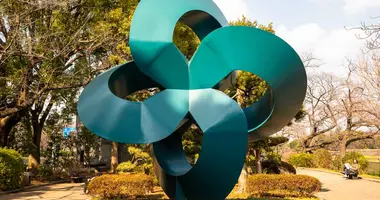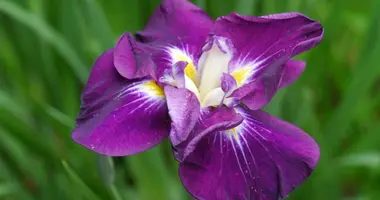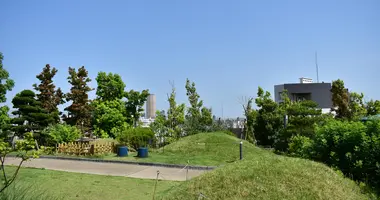Yoyogi Koen 代々木公園
- Published on : 01/12/2021
- by : SR
- Youtube
Yoyogi Park in Shinjuku is the ideal stop after a studious morning spent visiting temples and shrines. You will feel carefree upon leaving the park, which has a festive atmosphere.
Yoyogi Park, Tokyo
Yoyogi Park and the grounds of the adjacent Meiji Jingu Shrine form one of the largest and most easily accessible expanses of greenery in Tokyo.
Yoyogi Park's 54 hectares (133 acres) contain a variety of landscapes, from sunny lawn with ponds and fountains, to flower gardens, to shady forest groves. Yoyogi Park is dog- and cycle-friendly, has a car park, and with the proliferation of people there to practice, play, picnic, and chill, the people watching is unbeatable.
Every Sunday, the talents of the capital meet near the east entrance. Japanese Elvises and horn players reinterpret the classics of the 1950s while hip-hop dancers and gangs of rockabillies engage in lively jam sessions.
History of Yoyogi Park
The ground Yoyogi Park occupies was a military drill ground in 1909, and the next year became the site of Japan's first powered flight. It was taken over by the US Army for barracks in 1945, but gained true prominence only in 1964 as the Olympic Village for the athletes of the Tokyo Olympic Games.
It was not until 1967 that Yoyogi Park became a park - presently Tokyo's fourth biggest.
Yoyogi Park Layout
The center of Yoyogi Park is dominated by the Chuo Hiroba (Central Plaza), a grassy area that includes a large pond with fountains, a clock tower, drinking fountains, and a flower garden. People picnic, throw frisbee, exercise, and sunbathe here.
The wide margin surrounding Central Plaza has a variety of features such as a rose garden (with over 30 varieties), groves of various featured trees, including a sakura (cherry blossom) grove, and a food and drink store. The cherry grove, while small, is beautiful in spring, and the gingko grove in fall.
Features of Yoyogi Park
In the south-west corner of the park is the "Airplane Cradle" area, with its monument to the first ever powered flight in Japan (December 19, 1910) and two bronze busts of its aviators.
A remnant of accommodation from the Olympic Village remains in the south-east corner of the park, and nearby is the "Sample Garden" with trees grown from seeds brought over by the Olympic athletes from their various countries.
Next to the Sample Garden is a large fenced off area of land called the Bird Sanctuary, which also preserves the flora that is said to have typified the area before Tokyo became a city.
Yoyogi Park Cycling
The northern part of the park is for cycling. There is a large Yoyogi Park Cycling Center where bicycles can be hired for a modest hourly fee, and a dedicated concrete cycling track - no pedestrians allowed - through beautiful quiet forest. There is also a special Cycling Space for Children. However, you do not have to hire a bike to be able to use the cycling course.
- Cycling Center hours: 9 am-4 pm, closed Mondays (except when Monday is a public holiday, in which case, open Monday but closed Tuesday). Also, closed on rainy days, or when course conditions are otherwise poor.
Very near the cycling area is the Dog Run, where dog owners take their dogs and let them run free.
Yoyogi National Stadium
Yoyogi National Stadium (Kokuritsu Yoyogi Kyogi-jo) is across the road from Yoyogi Park. Yoyogi National Stadium was constructed 1961 to 1964 to stage swimming and diving events for the 1964 Summer Olympics. Yoyogi National Stadium was designed by the famous Japanese architect, Kenzo Tange. Yoyogi National Stadium is as much a venue for music concerts as for sports events. It includes the smaller Yoyogi Futsal Stadium.
Yoyogi Event Plaza with its outdoor stage is right next to Yoyogi National Stadium, across the road from the main park. On weekends, the area is usually crowded with people for an event of some kind happening here, often related to a national minority living in Japan. On either side of the Plaza are sports areas and courts for various sports, such as baseball, basketball and tennis.
Zelkova Avenue (Keyaki Namiki) is a 200 meter long pedestrian avenue lined with Japanese zelkova trees that leads from Yoyogi Event Plaza, past the headquarters of public broadcaster, NHK, to the top end of Shibuya.
Nearby
The youth fashion area of Harajuku is less than 10 minutes walk from Yoyogi Park. Also, if you cross the road to Yoyogi Event Plaza, you are in the Jinnan district that is part of Shibuya. The first attraction you come to is NHK Park, and further on, down the slope, is Shibuya shopping.
Address, timetable & access
Address
2-1 Yoyogikamizonocho, Shibuya City
151-0052
Japan
Timetable
24 hours a dayPrice
FreeAccess
JR Harajuku Station, Yamanote Line; Yoyogi-koen Station, Chiyoda Subway Line; Yoyogi-hachiman Station, Odakyu LineWebsite
http://www.tokyo-park.or.jp/park/format/index039.html#googtrans(en)






























